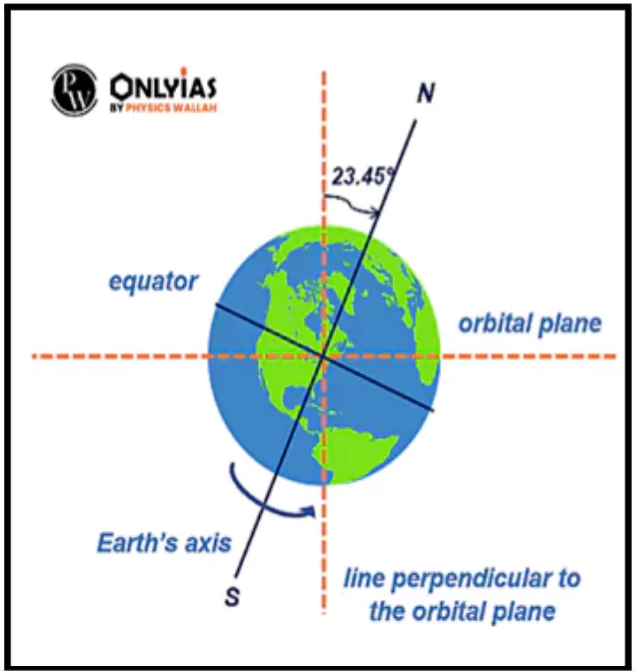Scientists have found that melting polar ice caps are causing the Earth to spin slower, resulting in tiny changes in day length.
Earth Rotation and Length of the Day on Earth

- Rotation of the Earth:
- The rotation of earth is the continuous spinning of our planet on its axis, which is an imaginary line passing through the North and South Poles.
- Day and Night: The rotation of earth is responsible for the cycle of day and night.
- As one side of the Earth faces the Sun, it experiences daylight, while the opposite side is in darkness, creating nighttime.
- The boundary between these regions is called the terminator.
- Duration: It takes approximately 24 hours for Earth to complete one full rotation, resulting in a wide range of fascinating natural phenomena and impacts on our daily lives.
- Length of the Day on Earth:
- The length of a day on Earth can be described in two ways:
- Sidereal Day: This is the time it takes for Earth to complete one full rotation relative to the distant stars. A sidereal day lasts approximately 23 hours and 56 minutes
- Solar Day: This is the time it takes for the Sun to return to the same position in the sky.
- A solar day, which we commonly refer to as a “day,” is approximately 24 hours.
- However, due to Earth’s variable rotation speed, solar days can be slightly longer or shorter than 24 hours.
Enroll now for UPSC Online Classes
- Some of the Factors Affecting the Length of the Day:
- Lunar Tidal Friction: Slows Earth’s rotation over time due to the Moon’s gravitational pull.
- Mass Distribution: Melting polar ice redistributes Earth’s mass from the poles toward the equator, which can alter the planet’s rotation speed.
- Earthquakes and Volcanic Activity: Large geological events can shift Earth’s mass, leading to minor changes in rotation speed.
- Crustal Rebound: After the last ice age, melting ice caused the Earth’s crust to rebound, which affected rotation.
- Ocean Currents: Large-scale changes in ocean currents can also influence rotational speed.
- Anthropogenic Activities: Large-Scale Engineering Projects or changes in land use can contribute to slight variations in Earth’s rotation.
Recent Findings
- Slowing of Earth Rotation: Over the past 20 years, melting ice has slowed Earth’s rotation by about 1.3 milliseconds per century. If high emission rates continue, this could increase to 2.6 milliseconds per century.
- Climate Change and Earth’s Rotation: Scientists have discovered that melting polar ice caps are causing Earth to spin more slowly. This change, though minute, affects how we measure time, which is crucial for technology like GPS and space travel.
- Impact of Melting Polar Ice
- Pole-to-Equator Mass Flux: Melting ice from polar regions moves towards the equator.
- Increased Oblateness: As ice melts, Earth’s shape becomes more elongated around the equator.
- Effect on Earth’s Rotation
- Slower Rotation: The redistribution of mass towards the equator causes Earth to spin more slowly.
- Longer Days: As a result, the time required for Earth to complete one rotation increases, lengthening the duration of a day.
- Impact on Technology: Although the changes are tiny, they are significant for precise timekeeping systems.
- Even small discrepancies can affect GPS, stock trading, and space missions.
- Current and Historical Trends: The Earth’s rotation is already affected by processes like lunar tidal friction, which slows it down by about 2 milliseconds per century.
- The addition of leap seconds helps keep atomic clocks in sync with Earth’s rotation.
- Effects of Ice Melt and Earth’s Core: Melting ice from the poles has caused the Earth’s crust to rebound, potentially speeding up the Earth’s rotation.
- Potential for a Negative Leap Second: This phenomenon could lead to debates about whether a negative leap second is needed to adjust for the faster rotation caused by the melting ice and other factors.
- Shifts in Earth’s Axis
- Earth’s Axis refers to the imaginary line that Earth rotates around, running vertically through the North and South Poles.
- Climate change and melting polar ice are affecting the axis of rotation.
- Research shows that melting ice drives the Earth’s polar motion, causing slight shifts in the axis of rotation.
- Consequences for Coastal Areas
- Rising sea levels from melting ice have more severe impacts on low-lying coastal areas than changes in rotational speed or axis wobble.
- These effects highlight the broader implications of climate change and the urgent need to reduce emissions.
Check Out UPSC NCERT Textbooks From PW Store
![]() 14 Aug 2024
14 Aug 2024
